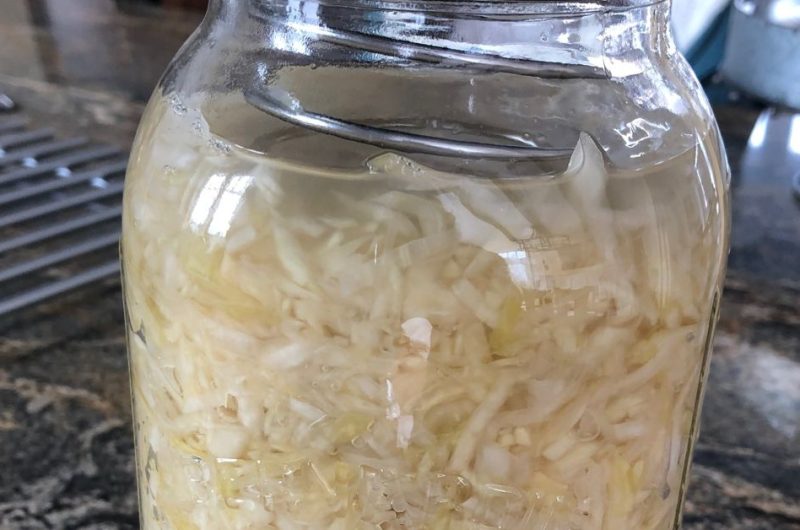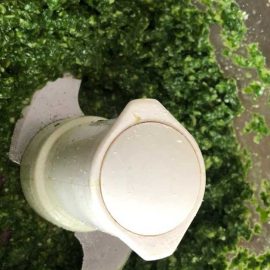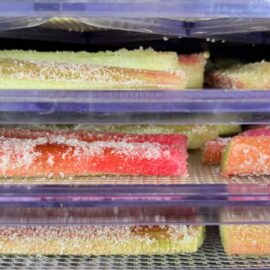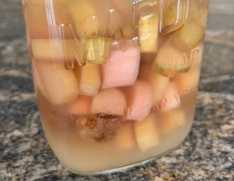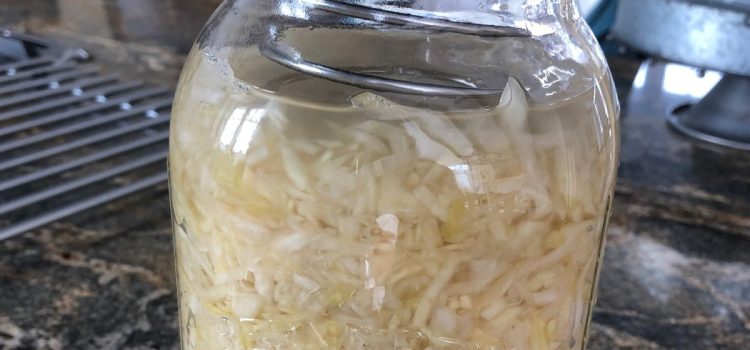
Interested in fermentation? Interested in other ways to use cabbages? Then look no further and start your next homemade journey into fermentation.
Sauerkraut is a great traditional fermentation food, and is so chock full of good gut health bacteria! Yes your gut will thank you!
Homemade sauerkraut also creates food flavours far superior to the grocery store stuff. Once you make it yourself, you won’t go back to that grocery store aisle. Homemade sauerkraut has a great crunch, and a sour, that is so special when you add it to your favourite Rueben sandwich, or your barbecued sausages. Shall we say yum!
Sauerkraut can be made in the traditional crocks of yesteryear, or you can make it a super simple way with a gallon Mason jar and a little accessory item. And yes, there are other work-arounds too, but this for me is a full-proof easy method.
Making Homemade Sauerkraut
I definitely call myself a DIY (Do-It-Yourself) person. Why? Because I am one of those people that need to know what I am eating and what is in it. The more wholesome the ingredients the better my body responds and then in turn my health is happier. So I make as much as possible vs. be a consumer of as much as possible.
Sauerkraut (using raw cabbage) is many times a fermentation first step without people even realizing they are starting to “ferment” foods within their own home.
Fermentation has so many health benefits, did you realize how important your “gut” health is? I am not going to get into that in this article. There are many articles on the web if you want to research more. In very simple terms though:
“Fermentation is the breakdown of carbs. It is a very old ancient technique for preserving food in a safe and easy way. The secret to it is lactic acid bacteria. To preserve vegetables using fermentation, they need to be submerged in an oxygen-free salty environment. Common fermented foods include kimchi, sauerkraut, kefir, tempeh, kombucha, and yogurt. Vitamins are not destroyed as the vegetables are fresh and raw when the process begins.”
What Do You Need to Make Sauerkraut?
No much really. Cabbage, salt, and a way to store it while it ferments.
Recipe Card
Difficulty: EasyIngredients
1 medium head green cabbage
1 1/2 tablespoons kosher salt
(or what I do to be more accurate is use:
1 tbsp. of salt per 1 kilogram of vegetables (2.2 lbs)1 tablespoon caraway seeds (optional, for flavour)
- ACCESSORIES
Cutting board
Sharp cutting knife
Mandolin (optional)
Large mixing bowl
1 Gallon Mason Jar or 2 Quart Mason Jars or a Crock
Canning funnel (optional)
Ball Lids and Fermentation Springs
Directions
- Get rid of any wilted, limp, rough outer leaves of the cabbage. Wash your cabbage. Slice the cabbage. I cut it into sections and then remove the core. (I do keep the discards for the chickens). Slice each section into very thin portions. You can have this as thick as you like, however the thicker it is, the crunchier and sometimes harder to chew.
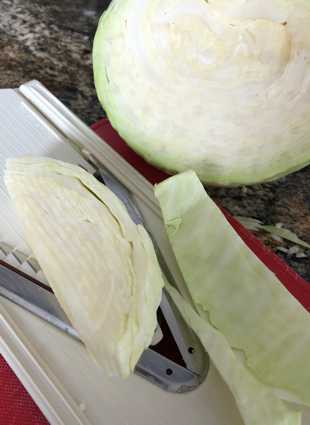
- Place all your thinly sliced cabbage pieces into your large mixing bowl. Add the salt to the cabbage. Begin massaging and squeezing the cabbage with your hands (is the easiest). At first you will think that it is not working or there is not enough salt, however you gradually after about 10 minutes, will see it become more watery and limp. If you choose to have caraway seeds in your sauerkraut you can add it now.
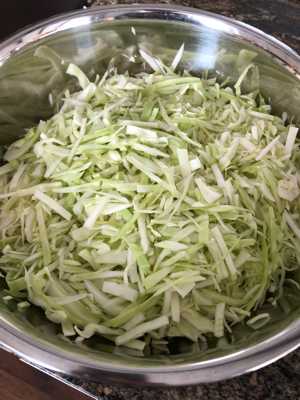
- Next, pack the cabbage into the Mason jar, pressing firmly with each addition. If you have a canning funnel, this will make the job easier as far as getting the cabbage within the jar itself vs. on your counter. Pour any liquid released by the cabbage into the jar.
- Then put your fermentation spring into the Mason jar with the wide part down. Then add the fermentation lid. It is important to use these lids as there are two tiny gas holes to release during the fermentation process. (Mine is made by Ball).

- You will see over the next 24-48 hours more liquid rise to be above the cabbage. Ferment the cabbage for 2 weeks to one month in a dark area away from sunlight of your home. A location that is not too cold or too hot (ideally 65°F to 75°F or 18°C to 24°C). The colder the area will slow down the fermentation process.
Start tasting it after 7 days — when the sauerkraut tastes good to you it can be refrigerated. Depending on how much cabbage you started with will vary on how long it takes to become sauerkraut.
- When it is fermenting, you may see bubbles, foam, white thicker juice, these are just signs that the process is working.
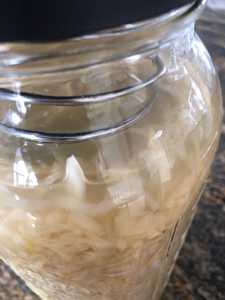
Notes
- Cautions: if you see any mold, skim it off immediately. This is usually because not all your cabbage was submerged below the liquid.
- Sidenote: You can use other types of cabbages to make sauerkraut too. Try red cabbage or add carrots for colour. Experiment and have fun!

